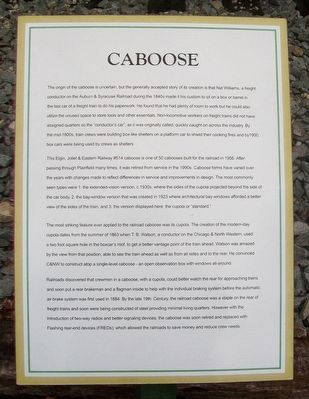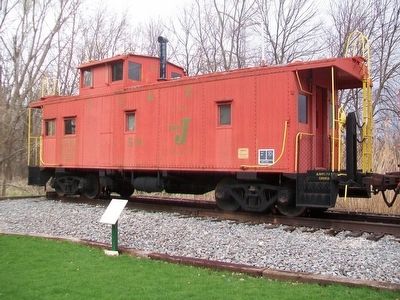Caboose
The origin of the caboose is uncertain, but the generally accepted story of its creation is that Nat Williams, a freight conductor on the Auburn & Syracuse Railroad during the 1840s made it his custom to sit on a box or barrel in the last car of a freight train to do his paperwork. He found that he had plenty of room to work but he could also utilize the unused space to store tools and other essentials. Non-locomotive workers on freight trains did not have assigned quarters so the "conductor's car", as it was originally called, quickly caught on across the industry. By the mid-1800s, train crews were building box-like shelters on a platform car to shield their cooking fires and by 1900, box cars were being used by crews as shelters.
This Elgin, Joliet & Eastern Railway #514 caboose is one of 50 cabooses built for the railroad in 1956. After passing through Plainfield many times, it was retired from service in the 1990s. Caboose forms have varied over the years with changes made to reflect differences in service and improvements in design. The most commonly seen types were 1. the extended-vision version, c.1930s, where the sides of the caboose projected beyond the side of the car body, 2. the bay-window version that was created in 1923 where architectural bay windows afforded a better view of the sides of the train, and 3. the
version displayed here, the cupola or "standard."The most striking feature ever applied to the railroad caboose was its cupola. The creation of the modern-day cupola dates from the summer of 1863 when T.B. Watson, a conductor on the Chicago & North Western, used a two foot square hole in the boxcar's roof, to get a better vantage of the train ahead as well as from all sides and to the rear. He convinced C&NW to construct atop a single-level caboose - an open observation box with windows all-around.
Railroads discovered that crewmen in a caboose, with a cupola, could better watch the rear for approaching trains and soon put a rear brakeman and a flagman inside to help with the individual braking system before the automatic air brake system was first used in 1884. By the late 19th Century, the railroad caboose was a staple on the rear of freight trains and soon were being constructed of steel providing minimal living quarters. However with the introduction of two-way radios and better signaling devices, the caboose was soon retired and replaced with Flashing rear-end devices (FREDs), which allowed the railroads to save money and reduce crew needs.
Erected by Plainfield Historical Society.
Topics. This historical marker is listed in this topic list: Railroads & Streetcars. A significant historical year for this entry is 1900.
Location.
Other nearby markers. At least 8 other markers are within walking distance of this marker. Boxcars (a few steps from this marker); E J & E Depot No. 4 (within shouting distance of this marker); The Lincoln Highway - The nation's first coast-to-coast highway! (about 300 feet away, measured in a direct line); Interurban Transportation (about 300 feet away); Village of Plainfield (about 300 feet away); Great American Crossroads in Illinois (about 300 feet away); Electric Park (about 500 feet away); Brownson-Martin House (approx. ¼ mile away). Touch for a list and map of all markers in Plainfield.
Also see . . . The Classic Caboose: An American Legend. (Submitted on April 24, 2016, by William Fischer, Jr. of Scranton, Pennsylvania.)
Credits. This page was last revised on August 27, 2020. It was originally submitted on April 24, 2016, by William Fischer, Jr. of Scranton, Pennsylvania. This page has been viewed 308 times since then and 11 times this year. Photos: 1, 2. submitted on April 24, 2016, by William Fischer, Jr. of Scranton, Pennsylvania.

